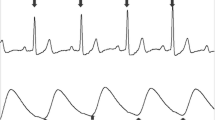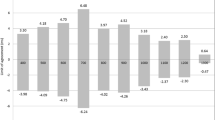Abstract
The heart rate (HR) variation to forced deep breathing (HRDB) and to the Valsalva maneuver (Valsalva ratio; VR) are the two most widely used tests of cardiovagal function in human subjects. The HR is derived from a continuously running electrocardiographic (ECG) recoding. Recently, HR derived from the arterial waveform became available on the Finapres device (FinapHR), but its ability to detect rapid changes in HR remains uncertain. We therefore evaluated HRDB and VR derived from FinapHR using ECG-derived HR (ECGHR) recordings as the standard. We also compared the averaged HR on Finapres (Finapav) with beat-to-beat Finapres (FinapBB) values. Studies were undertaken in 12 subjects with large HR variations: age, 34.5±9.3 (SD) years; six males and six females. FinapBB values were superimposable upon ECGHR for both HRDB and VR. In contrast, Finapav failed to follow ECGHR for HRDB and followed HRECG with a lag for the VR. To evaluate statistically how closely FinapHR approximated ECGHR, we undertook regression analysis, using mean values for each subject. To compare the two methods, we evaluated the signifiance of the difference between test and standard values. For HRDB, FinapBB reproducibly recorded HR (R2=0.998), and was significantly (p=0.001) better than Finapav (R2=0.616;p<0.001). For VR, HRBB generated a VR that was not significantly different from the correct values, while HRav generated a value that was slightly but consistently lower than the correct values (p<0.001). We conclude that FinapHR reliably records HR variations in the beat-to-beat mode for cardiovascular HR tests.
Similar content being viewed by others
References
Ewing DJ. Noninvasive evaluation of heart rate: the time domain. In: Low PA, ed.Clinical Autonomic Disorders: Evaluation and Management. Boston: Little, Brown and Company, 1993; 297–314.
Low PA. Laboratory evaluation of autonomic failure. In: Low PA, ed.Clinical Autonomic Disorders: Evaluation and Management. Boston: Little, Brown and Company, 1993; 169–195.
Penaz J. Photoelectric measurement of blood pressure, volume and flow in the finger. In: Albert R, Vogt WS, Helbig W, eds.Digest of the International Conference on Medicine and Biological Engineering. Dresden: Conference Committee on the Xth International Conference on Medicine and Biological Engineering, 1973; 104.
Wesseling KH, Settels JJ, van der Hoeven GM, Nijboer JA, Butjin MW, Dorlas JC. Effects of peripheral vasoconstriction on the measurement of blood pressure in a finger.Cardiovasc Res 1985;19: 139–145.
van Lieshout EJ, van Lieshout JJ, ten Harkel ADJ, Wieling W, Cardiovascular response to coughing; its value in the assessment of autonomic nervous control.Clin Sci 1989;77: 305–310.
van Lieshout EJ, van Lieshout JJ, Wieling W et al. Monitoring of finger blood pressure.J Neurol Neurosurg Psychiatry 1987;50: 503–504.
Imholz BPM, Settels JJ, van der Meiracker AH, Wieling W. Orthostatic circulatory control in the elderly evaluated by noninvasive continuous blood pressure measurement.Clin Sci 1990;79: 73–79.
Author information
Authors and Affiliations
Rights and permissions
About this article
Cite this article
Low, P.A., Opfer-Gehrking, T.L., Zimmerman, I.R. et al. Evaluation of heart rate changes: electrocardiographic versus photoplethys-mographic methods. Clinical Autonomic Research 7, 65–68 (1997). https://doi.org/10.1007/BF02267748
Received:
Accepted:
Issue Date:
DOI: https://doi.org/10.1007/BF02267748




